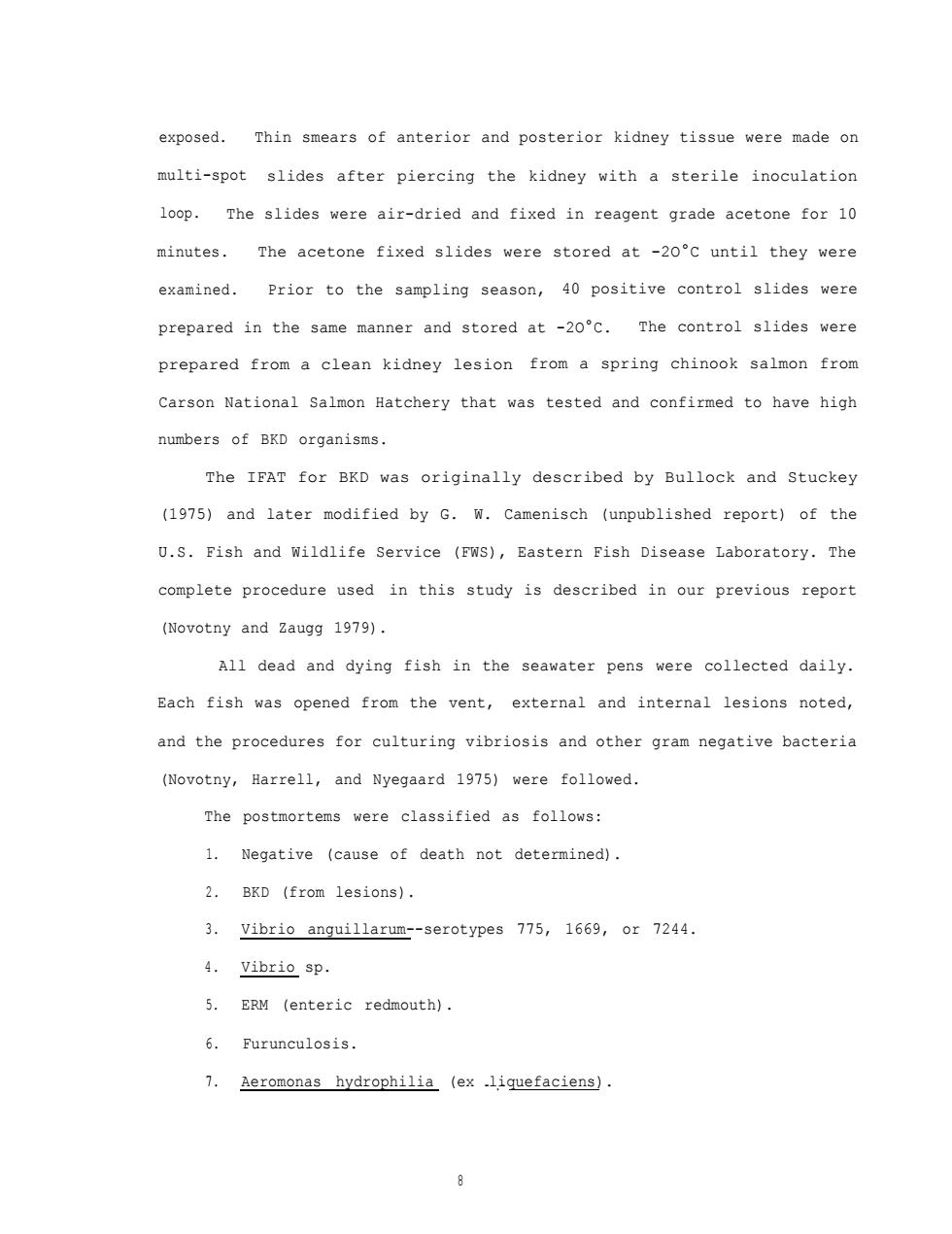正在加载图片...

exposed.Thin smears of anterior and posterior kidney tissue were made on multi-spot slides after piercing the kidney with a sterile inoculation loop.The slides were air-dried and fixed in reagent grade acetone for 10 minutes.The acetone fixed slides were stored at -20c until they were examined.Prior to the sampling season,40 positive control slides were prepared in the same manner and stored at-20C.The control slides were prepared from a clean kidney lesion from a spring chinook salmon from Carson National Salmon Hatchery that was tested and confirmed to have high numbers of BKD organisms. The IFAT for BKD was originally described by Bullock and Stuckey (1975)and later modified by G.W.Camenisch (unpublished report)of the U.S.Fish and Wildlife Service (FWS),Eastern Fish Disease Laboratory.The complete procedure used in this study is described in our previous report (Novotny and Zaugg 1979). All dead and dying fish in the seawater pens were collected daily. Each fish was opened from the vent,external and internal lesions noted, and the procedures for culturing vibriosis and other gram negative bacteria (Novotny,Harrell,and Nyegaard 1975)were followed. The postmortems were classified as follows: 1.Negative (cause of death not determined) 2.BKD (from lesions). 3.Vibrio anquillarum--serotypes 775,1669,or 7244. 4.Vibrio sp. 5.ERM (enteric redmouth). 6.Furunculosis. 7.Aeromonas hydrophilia (ex.liquefaciens)exposed. Thin smears of anterior and posterior kidney tissue were made on multi-spot slides after piercing the kidney with a sterile inoculation loop. The slides were air-dried and fixed in reagent grade acetone for 10 minutes. The acetone fixed slides were stored at -2O°C until they were examined. Prior to the sampling season, 40 positive control slides were prepared in the same manner and stored at -2O°C. The control slides were prepared from a clean kidney lesion from a spring chinook salmon from Carson National Salmon Hatchery that was tested and confirmed to have high numbers of BKD organisms. The IFAT for BKD was originally described by Bullock and Stuckey (1975) and later modified by G. W. Camenisch (unpublished report) of the U.S. Fish and Wildlife Service (FWS), Eastern Fish Disease Laboratory. The complete procedure used in this study is described in our previous report (Novotny and Zaugg 1979). All dead and dying fish in the seawater pens were collected daily. Each fish was opened from the vent, external and internal lesions noted, and the procedures for culturing vibriosis and other gram negative bacteria (Novotny, Harrell, and Nyegaard 1975) were followed. The postmortems were classified as follows: 1. 2. 3. 4. 5. 6. 7. Negative (cause of death not determined). BKD (from lesions). Vibrio anguillarum--serotypes 775, 1669, or 7244. Vibrio sp. ERM (enteric redmouth). Furunculosis. Aeromonas hydrophilia (ex liquefaciens). - .- 8